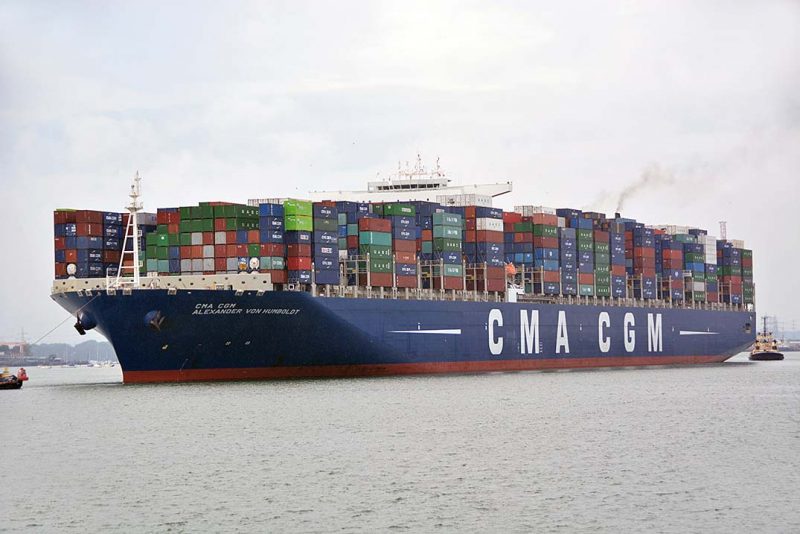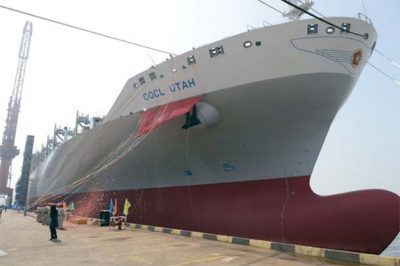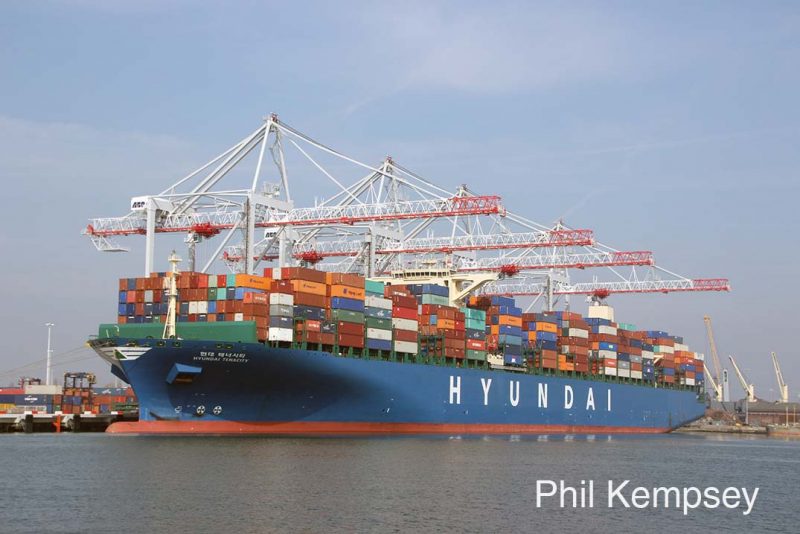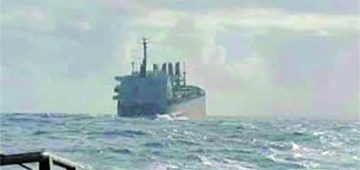APL announced on 20th July that its Bosphorus Express (BEX) service would be making additional calls at Beirut and Iskenderun as of 27th July, extending market coverage of the service that serves Asia, the Mediterranean and Europe. With the new port calls, the BEX will call at the ports of Kwangyang, Busan, Yangshan, Ningbo, Chiwan, Port Klang, Port Said West, Beirut, Iskenderun, Izmit, Istanbul, Constanta and Odessa. On 27th July APL launched the Felixstowe Express Service (FEX), a new weekly service that connects the key ports of China, Europe and Felixstowe. APL said that the new FEX service marks an important expansion of its Asia-Europe service network as it begins calling at Felixstowe. The new FEX service will complement APL’s existing port calls to Southampton and will call at the ports of Qingdao, Yangshan, Ningbo, Xiamen, Yantian, Port Klang, Felixstowe, Rotterdam and Hamburg. The first sailing departed from Qingdao on 20th August 2016. APL’s West Coast 5 (WC5) service will be serving the additional ports of Corinto, Acajutla and Puerto Quetzal in Central America, as revealed on 2nd August, enhancing direct connectivity between the Port of Los Angeles and the Latin American markets. The service has been refined to better support trade activities between Central America and the USA. So, as from 14th September, the enhanced service will call at the ports of Los Angeles, Lazaro Cardenas, Corinto, Acajutla and Puerto Quetzal every week.
CMA CGM has upgraded its EURAF 4 service connecting Europe to West Africa strategic markets. As of 26th July a new vessel sharing agreement saw the CMA CGM Group contribute 6 vessels of 8 and the fleet is being upgraded from 2,500 TEU ship capacity to 3,100-3,500 TEU capacity ships. The service is also improved with weekly calls at Bata and Malabo. The previous service, the Equatorial Guinea Express, was discontinued from the call of the 30,051gt/2004 built Gisele A at Algeciras on 18th July. The direct service from the Western Mediterranean to Equatorial Guinea with shortened transit times means that Bata is now reached from Livorno in 20 days and Malabo from Valencia in 19 days. The new EURAF 4 rotation is as follows: Livorno – Genoa – Marseilles – Barcelona – Valencia – Algeciras – Tangiers – Lome – Bata – Malabo – Onne (fortnightly) – Port Gentil – Libreville – Douala – Lome NB (fortnightly) – San Pedro (fortnightly) – Algeciras – Livorno. As of 15th July CMA CGM NAF Lines resumed the EURONAF service from Barcelona to Djen Djen using the 9,981gt/2005 built Vega Omikron. CMA CGM was the first line to launch a container vessel into Djen Djen in October 2013 in order to offer a solution without using the congested port of Bejaia.
On 10th August CMA CGM unveiled plans to revise the ports of call of its FAL1 service. As of voyage 115FLE, the service ceased calling at Zeebrugge. The last call at Zeebrugge was the 178,228gt/2015 built CMA CGM Vasco De Gama, voyage 113FLE on 29th August. Also, as of voyage 109FLE, the 175,343gt/2013 built CMA CGM Alexander Von Humboldt (above) missed a call at Dalian. The last call there was voyage 107FLE with the 150,269gt/2010 built CMA CGM Magellan on 16th September. Once those 2 changes were implemented, the new rotation of FAL1 is the following: Southampton – Dunkirk – Hamburg – Rotterdam – Le Havre – Malta – Khor Al Fakkan – Jebel Ali – Shanghai – Tianjin Xingang – Busan – Qingdao – Shanghai (WB) – Ningbo – Yantian – Port Kelang – Algeciras – Southampton. On 11th August the company reported an ungrade to its EURAF 1 service by adding a new port of call, Vlissingen, to its loop. Effective from the 41,974dwt and 3534 TEU capacity CMA CGM Partici on 9th September, the EURAF 1 service deployed on Europe – West Africa trades. The calls will now be Dunkirk – Tilbury – Antwerp – Vlissingen – Dunkirk – Le Havre – Montoir – Tangier Med – Algeciras – Dakar – Abidjan – Dakar – Algeciras – Dunkirk. Further service enhancements followed on 30th August when its new EURAF 6 service commenced via a slot swap agreement with a partner using the 25,580gt/2002 built CMA CGM Milan Trader on a secondary Europe-West Africa loop from Italy and Spain to Senegal, Ivory Coast, Nigeria and Ghana with the transit time vastly improved by up to 6 days. The service calls at La Spezia, Genoa, Tarragona, Castellon, Valencia, Algeciras, Tangiers, Dakar, Abidjan, Tin Can/Lagos, Tema, Takoradi, Abidjan and La Spezia.
Hapag-Lloyd AG and United Arab Shipping Company S.A.G. (UASC) signed a Business Combination Agreement (BCA) on 18th July to merge both companies, subject to the necessary regulatory and contractual approvals. Besides the Business Combination Agreement (BCA) between the two companies, namely CSAV Germany Container Holding GmbH, HGV Hamburger Gesellschaft für Vermögens- und Beteiligungsmanagement mbH and Kühne Maritime GmbH on the side of Hapag-Lloyd, and Qatar Holding LLC on behalf of the State of Qatar and The Public Investment Fund of the Kingdom of Saudi Arabia on the side of UASC, have assumed certain commitments with regard to the merger and the future equity funding of the company in a separate agreement, the so-called Shareholders Support Agreement (SSA). In that agreement some of the controlling shareholders of either side have committed, to backstop a cash capital increase in the amount of $400 million planned by way of a rights issue within six months after the closing of the transaction. Following the integration, the new Hapag-Lloyd will rank among the five largest container shipping lines in the world, with 237 vessels and a total transport capacity of around 1.6 million TEU, an annual transport volume of 10 million TEU and a combined turnover of approximately $12 billion. The combined company will remain a registered and stock listed company in Germany with its head office in Hamburg. CSAV, HGV (City of Hamburg) and Kühne Maritime will remain controlling shareholders of Hapag-Lloyd. The majority shareholders of UASC, Qatar Holding LLC (QH) and The Public Investment Fund of the Kingdom of Saudi Arabia (PIF), will become new key shareholders of Hapag-Lloyd holding 14 per cent (QH) and 10 per cent (PIF) respectively. The fleet of the combined company will include UASC´s six recently delivered 18,800 TEU ships, known for their superior eco-efficiency credentials, as well as eleven newly built 15,000 TEU ships, the last of which will be delivered during 2016. With an average age of 6.6 years and average size of 6,600 TEU the combined company will have one of the most modern and efficient vessel fleets in the industry.
The company will be the key player in the new “THE Alliance”, consisting of Hanjin, Hapag-Lloyd, K-Line, Mitsui O.S.K Lines, Nippon Yusen Kaisha and Yang Ming. THE Alliance is scheduled to begin operation in April 2017 and will cover all East-West trade lanes including Asia- Middle East/Arabian Gulf and Red Sea. Following regulatory and contractual approvals, the merger is expected to be completed by the end of 2016. Until then, UASC and Hapag-Lloyd will continue to operate as stand-alone companies. As a result of the merger, United Arab Shipping Co. (UASC) is considering the $600m sale of its tanker business for oil and petrochemicals United Arab Chemical Carriers Ltd. (UACC). UASC holds 95 percent of UACC, which was founded in 2007. The G6 Alliance, of which Hapag-Lloyd is a partner at present, announced on 22nd July that the CC1 and CC2 Asia-North America West Coast services would merge in response to changes in market demand. The changes took place when the 91,499gt/2015 built OOCL Utah (above) called at Qingdao eastbound on 30th July and when the same ship called at Los Angeles/Long Beach on 18th August. All other services of the G6 Alliance will remain unchanged.
COSCO Corporation (Singapore) Limited has secured an order from a European buyer to build three 1,750 TEU containerships at the company’s COSCO Guangdong shipyard. The 172m long and 28.4m beam container vessels are scheduled for delivery in the second and third quarter of 2019, respectively. The deal comes with an option for further three containerships of the same type.
Hyundai Merchant Marine Co. confirmed in July that it will join the world’s biggest shipping alliance, 2M, from April 2017. The group, led by A.P. Moeller-Maersk A/S and MSC, will seek approval from the relevant authorities for the partnership. Joining the alliance will help struggling Hyundai Merchant reduce costs and improve its competitiveness, whilst also enabling Maersk Line and MSC to bolster their services on trans-Pacific routes.
MSC christened the 192,237gt/2015 built MSC Sveva (above) at Le Havre on 20th July. The 395.4m long and 19,224 TEU capacity Oscar Class ship, launched in October 2015, is named after Sveva, the daughter of Gianni Onorato. The 194,389gt/2016 built MSC Diana undertook her maiden call at Southampton on 10th August. The 399.9m long giant can accommodate 19,624 TEUs. The MSC Diana is the first of six ships ordered from Samsung Heavy Industries, her sister ships that so far have names allocated will be the MSC Ingy (delivered and in service), MSC Eloane, MSC Marjam plus two other unnamed vessels due in 2017.

Orient Overseas Container Line (OOCL) launched a new Asia- Adriatic service (AAS) in August, extending its existing Mediterranean network to the Adriatic region. The westbound voyage from ETA Shanghai started on 25th August while the eastbound voyage from ETA Koper commenced on 24th September. The new service provides coverage between Asia and Adriatic ports, including Italy, Slovenia and Croatia, on top of the company’s existing inland network throughout Central Europe. The AAS will have the following port rotation: Shanghai – Ningbo – Busan – Chiwan – Tanjung Pelepas – Port Kelang – Koper – Trieste – Rijeka – Venice – Koper – Malta – Jeddah – Port Kelang – Tanjung Pelepas – Nansha – Shanghai. The ship deployed is the 66,433gt/2004 built Xin Yan Tian.
The company is to cancel the sailing of its Asia-Mediterranean EUM Service in October due to the expected low demand. The affected ship will be the 141,770gt/2012 built Hyundai Tenacity (above) with her 022 west/east itinerary, with an estimated time of arrival in Pusan of 9th October, in Week 41 on the westbound port rotation and in Genoa on 9th November, in Week 45 on the eastbound port rotation. The Asia- Europe service was the only underperformer for the period, marking a 3.6% drop in volumes, other services performed better.
Oldenburg-Portugiesische Dampfschiffs-Rhederei (OPDR) has optimised its Canary Islands and Iberian Peninsula (CISS) service by offering a direct connection from Leixões, Lisbon and Gibraltar to Hamburg. The service started from August with transit times of five, six and eight days, respectively.
Three ships with capacities of 700 TEU each are deployed on the new CISS service. OPDR currently offers seven weekly connections from the European mainland to the United Kingdom, three of which are attributed to the CISS service – Hamburg to Tilbury once a week, Rotterdam to Tilbury twice a week. Additional connections from Hamburg and Rotterdam to UK’s Port of Immingham are planned for the fourth quarter of the year. The port rotation is: Hamburg – Rotterdam – Tilbury – St. Cruz de Tenerife – Las Palmas de Gran Canaria – Agadir – Casablanca – Gibraltar – Algeciras – Lisbon – Leixões – Rotterdam – Tilbury – Hamburg.
Rickers Maritime of Singapore is reportedly consdering laying up some of the 11 containerships it has operating in the spot market to save costs when the vessels are redelivered. The company has a fleet of 16 containerships of between 3,450 TEU and 5,060 TEU. The fleet is 72% employed for 2016 and saw utilisation of 91.4% during the second quarter. Charterers include CMA CGM, Maersk Line, Mitsui OSK Lines and MSC.
Maersk Line announced on 21st July that it will transform its TP12 service into a standalone, around-the-world service that provides significantly faster transit times between Far East Asia and the US East Coast. From the Far East to the US East Coast the TP12 service will transit the new Panama Canal locks and call at the ports of Newark, Norfolk and Baltimore on the US East Coast. On the return leg to Asia, the TP12 will go through the Suez Canal and call at the ports of Salalah (Oman), Colombo (Sri Lanka) and Singapore. This change will significantly improve Maersk Line’st offering to shippers on the Far East Asia and the US East Coast trade. Maersk Line also improved other services this summer, adding Busan in South Korea to the Westbound TP10 service. This will significantly improve transit times from Charleston and Savannah on the US East Coast to Busan and North China. In addition, Maersk Line is connecting its TP11 and TP8 services to form a pendulum service that expands the coverage of both services. The TP18 service will remain unchanged, as will the capacity in Maersk Line’s Asia-US East Coast network with 11 ships of 8,500 TEU deployed in the new TP12 service and 17 ships of 8,500 TEU in the new TP11/TP8 pendulum service.
The company has embarked upon a project to upgrade its eight 170,794gt and 15,550 TEU capacity E-class vessels to accommodate a further 1,300 TEU. The work involves raising the accommodation block and wheelhouse and increasing the height of lashing bridges to take an extra tier of containers. This scheme is part of the strategy to double the lifetime of the 10-year-old ships, and could, perhaps, be viewed as a statement from Maersk on maximum vessel size intent. Remedial work was needed on the E-Class ships after the Emma Maersk was fortunate not to sink at the northern entrance to the Suez Canal in early 2013 after the hull was fractured by a failed stern thruster. The upgrading, which also includes fitting a new bulbous bow to handle slower speeds and a new propeller, is being carried out at China’s CSIC Qingdao Beihai Shipyard, which has undertaken the majority of previous Maersk Line ship upgrades. Reports state that the first ship to be upgraded was the Eugen Maersk and she is now back on the 2M AE1/Shogun Asia-North Europe loop. In 2015, Maersk announced that it had placed an order for 11 (plus six optional) second-generation Triple-Es with a capacity of 19,630 TEU for delivery during 2017-2018.
In mid-July the 94,730gt/2015 built Maersk Shams (above) grounded in the Suez Canal causing some of the vessels in the convoy to be delayed. The containership was refloated using tugs. To quash rumours, Maersk Line officially announced in August that it will not take over debt-ridden Hyundai Merchant Marine (HMM). The company also discontinued services from 10 Chinese ports for both import and export shipments, effective 1st September. The culled ports are Port of Chizhou, Luzhou, Yingkou, Rizhao, Jinzhou, Yueyang, Lijiao, Taiping, Jiaoxin and Nansha old port. The second quarter of 2016 saw Maersk Line reveal a loss of $151 million, largely thanks to a fall in freight rates by a record 24%.
Seago Line, a subsidiary of Maersk Line, has introduced a new vessel, the Independent Accord, to its feeder service calling at Liverpool, UK. The vessel serves the new cargo route between Algeciras, Liverpool, and Dublin, which was launched in April 2016. The 15,345gt/2007 built and 1,579 TEU capacity Independent Accord replaces the 14,063gt/1999 built and 1,100 TEU capacity Antwerp, which had operated the route since April.










Comments
Sorry, comments are closed for this item